
FEATURED CONTENTS
Crazyflie plug-in for the ARGoS simulator
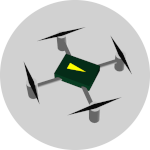
We present our new ARGoS plug-in implementing the Crazyflie drone, including its controllers, sensors, and some expansion decks. We have based our development on the former Spiri drone, upgrading the position controller, adding a new speed controller, LED ring, onboard camera, and battery discharge model.
An E-Puck2 robot plug-in for the ARGoS simulator
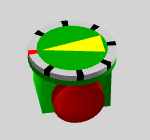
We present a new plug-in for the ARGoS swarm robotic simulator to implement the E-Puck2 robot model, including its graphical representation, sensors and actuators. We have based our development on the former E-Puck robot model (version 1) by upgrading the existing sensors (proximity, light, ground, camera, and battery) and adding new ones (time of flight and simulated encoders) implemented from scratch.
Flow Generator Algorithm

We present a novel approach for calculating realistic traffic flows for traffic simulators, called Flow Generator Algorithm (FGA). We start with an original map from OpenStreetMap and traffic data collected at different measurement points, published by the city’s authorities, to produce a model consisting of the simulation map and a series of traffic flows (routes + vehicles) which match the real number of vehicles at those streets.
Yellow Swarm
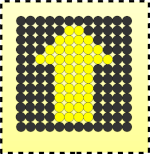
Traffic congestion is one of the main concerns of citizens living in big cities. In this article we propose a novel system, called Yellow Swarm, with the aim of improving road traffic at a low cost and easy implementation by using a set of LED panels placed throughout the city in order to spread road traffic over its streets.
Green Swarm

The mobility architecture, called Green Swarm, is proposed to reduce greenhouse gas emissions from road traffic in smart cities. The traffic flow optimization of four European cities: Malaga, Stockholm, Berlin, and Paris, is addressed with new case studies importing each city's actual roads and traffic lights from OpenStreetMap.
Red Swarm
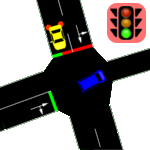
Nowadays, cities are evolving quickly. Most citizens are living in, using the services of, or thinking about moving to cities, what is a new source of complex problems. Smart Cities is a world initiative leading to better exploit on of the resources in a city in order to offer higher level services to people.
The epiGenetic Algorithm
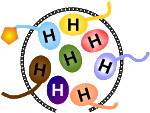
Our novel proposal, the epiGenetic Algorithm (epiGA), consists of a set of strategies, based on evolutionary computation, inspired in nature, especially in epigenetics, with the aim of solving complex combinatorial problems. We are interested in how the DNA and histones are collapsed to form nucleosomes, how this affects gene replication during reproduction, and how epigenetic mechanisms modify gene expression through methylation. Source code in GitLab: JAVA and Python
Project CoMVeT
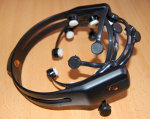
The Emotiv EPOC neuroheadset is used to register neural activity with high resolution. This activity is processed and sent to the computer using a wireless link. This neuroheadset represents a new type of interface human-machine (HCI) and it's able to interpret signals from the user's brain. This neuroheadset has several wet pads used like electrodes to detect the user's basic thoughts, feelings, emotions and facial gestures.
Project VIGIA

The Project VIGIA is a development that took place during the subject Software Engineering: Projects. It consisted in a system capable to control a remote webcam by using the movements of the user's head simulating a virtual window behaviour. To do that, a Wiimote will be used to detect the head position in conjunction with a pair of glasses provided with infrared LEDs.
MULTIMEDIA CONTENTS
RESEARCH PROJECTS

The COMBO project (Optimal integration of connected and automated shuttles with passenger and freight transport systems) targets studying the implications, benefits, and impacts on the medium and long-term resulting from the integration of connected and autonomous shuttles with existing transport systems. The project will elaborate a decision-making system to facilitate this integration. Read more...

The ADARS project (Automating the Design of Autonomous Robot Swarms) aims to propose a unique solution to the design of distributed autonomous systems by addressing the following question: is it possible to automatically generate efficient and reusable behaviors for distributed aerospace and space systems (DASS)? To this end, ADARS will advance the state-of-the-art in the field of swarm robotics and automated algorithm design. Read more...
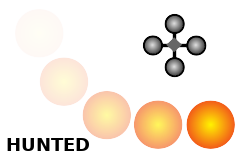
The HUNTED project (Heterogeneous multi-swarms of UNmanned auTonomous systEms for mission Deployment) aims at designing a novel generation of mobility models for heterogeneous multi-swarms of Unmanned Autonomous Systems (UAS) for surveillance and tracking of imminent threats. Such swarms are composed of several vehicles moving in an autonomous and coordinated manner in the air, on the ground, and in the sea. Read more...
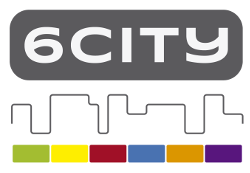
In the 6CITY project (TIN2017-88213-R) the working hypothesis is that many different problems of smart cities (according to EU: economy, mobility, governance, people, living, environment), which are multidisciplinary in nature and apparently unrelated, can be solved by looking at their (possibly similar) underlying quantitative and qualitative features, as well as by providing advanced algorithms that can search, optimize and learn by themselves (to an extent) for those situations where knowledge of the problem is very limited (as it happens in many real cases). Read more...

The MOVEON project (TIN2014-57341-R) makes an ambitious proposal for focused research in challenges related to intelligent transport and smart mobility. We do it from the perspective of building new applications based in solver metaheuristic engines enhanced with methodologies and theories contributed by our team so as to exhibit "holistic intelligence". Read more...

The MAXCT project (OTRI # 8.06/5.47.4356 - AOP GGI3003IDI) consists of two parallel applications are running to improve the traffic flow in a city: HITUL - Holistic Intelligence for Traffic Urban Lights - system offers an informed support for decision-making at city level, optimizing the planning of the existing traffic lights network; and CTPATH is our second tool in this project. Drivers could receive route advices based in their preferences and city conditions, both powered to reduce the travel times and the carbon footprint. Read more...

The roadME project (TIN2011-28194) intends to characterize, design, and evaluate metaheuristic techniques able to solve real world problems, and then, particular applications of a communication network of vehicles (VANET). Our hypothesis is that standard metaheuristics are not able by themselves to address the tight requirements of many complex problems like this one, since we are dealing with execution times of a few seconds, specific user constraints, scalable to very big dimension problems, and robust to work in different scenarios. Read more...

The Project PATIO: Collaborative Learning and User Modelling Techniques Applied to Multicultural Integration (TIC-4273), has been developed by the group of Investigation and Application of Artificial Intelligence of the Department of Computer Science and Programming Languages of the University of Málaga, subsidized by the Ministry of Innovation, Science and Business of the Andalusian Regional Government (2008 official announcement for excellence Projects). Read more...
JOURNAL PUBLICATIONS
Full List
Optimising Last-Mile Parcel Delivery Using Connected Autonomous Shuttles
Daniel H. Stolfi and Cindy Guerlain and Sébastien Faye. Optimising Last-Mile Parcel Delivery Using Connected Autonomous Shuttles. In: IEEE Access, pp. 1-1, 2025.
doi> 10.1109/ACCESS.2025.3637526 | [BibTex]@Article{Stolfi2025b,
author = {Stolfi, Daniel H. and Guerlain, Cindy and Faye, S\'{e}bastien},
journal = {IEEE Access},
title = {Optimising Last-Mile Parcel Delivery Using Connected Autonomous Shuttles},
year = {2025},
pages = {1-1},
doi = {10.1109/ACCESS.2025.3637526},
keywords = {Logistics;Postal services;Proposals;Genetic algorithms;Urban areas;Space shuttles;Heuristic algorithms;Costs;Routing;Silicon;parcel delivery;autonomous shuttles;last-mile delivery;parcel locker;city logistics;genetic algorithm},
}

Connectivity-Aware Route Design and Frequency Setting for Connected and Automated Shuttles
Elhadja Chaalal and Daniel H. Stolfi and Ayat Zaki-Hindi and Sébastien Faye. Connectivity-Aware Route Design and Frequency Setting for Connected and Automated Shuttles. In: IEEE Access, vol. 13, pp. 173939-173951, 2025.
doi> 10.1109/access.2025.3615310 | [BibTex]@Article{Chaalal2025,
author = {Chaalal, Elhadja and Stolfi, Daniel H. and Zaki-Hindi, Ayat and Faye, S\'{e}bastien},
journal = {IEEE Access},
title = {Connectivity-Aware Route Design and Frequency Setting for Connected and Automated Shuttles},
year = {2025},
issn = {2169-3536},
pages = {173939--173951},
volume = {13},
doi = {10.1109/access.2025.3615310},
publisher = {Institute of Electrical and Electronics Engineers (IEEE)},
}

Escorting drone swarm formation: a swarm intelligence and evolutionary optimisation approach
Daniel H. Stolfi and Grégoire Danoy. Escorting drone swarm formation: a swarm intelligence and evolutionary optimisation approach. In: Swarm Intelligence, vol. 19, No. 3, pp. 245-272, 2025.
doi> 10.1007/s11721-025-00250-5 | [BibTex]@Article{Stolfi2025,
author = {Stolfi, Daniel H. and Danoy, Gr\'{e}goire},
journal = {Swarm Intelligence},
title = {Escorting drone swarm formation: a swarm intelligence and evolutionary optimisation approach},
year = {2025},
issn = {1935-3820},
month = jun,
number = {3},
pages = {245--272},
volume = {19},
doi = {10.1007/s11721-025-00250-5},
groups = {My Publications},
publisher = {Springer Science and Business Media LLC},
}

Evolutionary swarm formation: From simulations to real world robots
Daniel H. Stolfi and Grégoire Danoy. Evolutionary swarm formation: From simulations to real world robots. In: Engineering Applications of Artificial Intelligence, vol. 128, pp. 107501, 2024.
doi> 10.1016/j.engappai.2023.107501 | [BibTex]@Article{Stolfi2024,
author = {Daniel H. Stolfi and Gr\'{e}goire Danoy},
journal = {Engineering Applications of Artificial Intelligence},
title = {Evolutionary swarm formation: From simulations to real world robots},
year = {2024},
issn = {0952-1976},
pages = {107501},
volume = {128},
doi = {10.1016/j.engappai.2023.107501},
groups = {My Publications},
keywords = {Swarm robotics, Evolutionary algorithm, E-Puck2, ARGoS simulator, Robot formation},
url = {https://www.sciencedirect.com/science/article/pii/S0952197623016858},
}

Optimising Robot Swarm Formations by Using Surrogate Models and Simulations
Daniel H. Stolfi and Grégoire Danoy. Optimising Robot Swarm Formations by Using Surrogate Models and Simulations. In: Applied Sciences, vol. 13, No. 10, 2023.
doi> 10.3390/app13105989 | [BibTex] | [Files]@Article{Stolfi2023a,
author = {Stolfi, Daniel H. and Danoy, Gr\'{e}goire},
journal = {Applied Sciences},
title = {Optimising Robot Swarm Formations by Using Surrogate Models and Simulations},
year = {2023},
issn = {2076-3417},
number = {10},
volume = {13},
article-number = {5989},
doi = {10.3390/app13105989},
url = {https://www.mdpi.com/2076-3417/13/10/5989},
}

Design and analysis of an E-Puck2 robot plug-in for the ARGoS simulator
Daniel H. Stolfi and Grégoire Danoy. Design and analysis of an E-Puck2 robot plug-in for the ARGoS simulator. In: Robotics and Autonomous Systems, vol. 164, pp. 104412, 2023.
doi> 10.1016/j.robot.2023.104412 | [BibTex] | [Files]@Article{Stolfi2023,
author = {Daniel H. Stolfi and Gr\'{e}goire Danoy},
journal = {Robotics and Autonomous Systems},
title = {Design and analysis of an {E-Puck2} robot plug-in for the {ARGoS} simulator},
year = {2023},
issn = {0921-8890},
pages = {104412},
volume = {164},
doi = {10.1016/j.robot.2023.104412},
keywords = {E-puck2, ARGoS, Computer simulations, Sensors, Swarm robotic},
url = {https://www.sciencedirect.com/science/article/pii/S0921889023000519},
}

An Evolutionary Algorithm to Optimise a Distributed UAV Swarm Formation System
Daniel H. Stolfi and Grégoire Danoy. An Evolutionary Algorithm to Optimise a Distributed UAV Swarm Formation System. In: Applied Sciences, vol. 12, No. 20, 2022.
doi> 10.3390/app122010218 | [BibTex]@Article{Stolfi2022b,
author = {Stolfi, Daniel H. and Danoy, Gr\'{e}goire},
journal = {Applied Sciences},
title = {An Evolutionary Algorithm to Optimise a Distributed UAV Swarm Formation System},
year = {2022},
issn = {2076-3417},
number = {20},
volume = {12},
article-number = {10218},
doi = {10.3390/app122010218},
url = {https://www.mdpi.com/2076-3417/12/20/10218},
}

SuSy-EnGaD: Surveillance System Enhanced by Games of Drones
Daniel H. Stolfi and Matthias R. Brust and Grégoire Danoy and Pascal Bouvry. SuSy-EnGaD: Surveillance System Enhanced by Games of Drones. In: Drones, vol. 6, No. 1, 2022.
doi> 10.3390/drones6010013 | [BibTex] | [Files]@Article{drones6010013,
AUTHOR = {Stolfi, Daniel H. and Brust, Matthias R. and Danoy, Gr\'{e}goire and Bouvry, Pascal},
TITLE = {{SuSy-EnGaD}: Surveillance System Enhanced by Games of Drones},
JOURNAL = {Drones},
VOLUME = {6},
YEAR = {2022},
NUMBER = {1},
ARTICLE-NUMBER = {13},
URL = {https://www.mdpi.com/2504-446X/6/1/13},
ISSN = {2504-446X},
DOI = {10.3390/drones6010013},
FILE = {https://gitlab.uni.lu/hunted/susy-engad-surveillance-system-enhanced-by-games-of-drones}
}

A competitive Predator–Prey approach to enhance surveillance by UAV swarms
Daniel H. Stolfi and Matthias R. Brust and Grégoire Danoy and Pascal Bouvry. A competitive Predator–Prey approach to enhance surveillance by UAV swarms. In: Applied Soft Computing, vol. 111, pp. 107701, 2021.
doi> 10.1016/j.asoc.2021.107701 | [BibTex] | [Files]@article{Stolfi2021c,
title = {A competitive Predator–Prey approach to enhance surveillance by UAV swarms},
journal = {Applied Soft Computing},
volume = {111},
pages = {107701},
year = {2021},
issn = {1568-4946},
doi = {10.1016/j.asoc.2021.107701},
author = {Daniel H. Stolfi and Matthias R. Brust and Gr\'{e}goire Danoy and Pascal Bouvry},
keywords = {Swarm robotics, Computer simulation, Mobility model, Unmanned aerial vehicle, Competitive coevolutionary genetic algorithm},
}

Yellow Swarm: LED panels to advise optimal alternative tours to drivers in the city of Malaga
Daniel H. Stolfi and Enrique Alba. Yellow Swarm: LED panels to advise optimal alternative tours to drivers in the city of Malaga. In: Applied Soft Computing, vol. 109, pp. 107566, 2021.
doi> 10.1016/j.asoc.2021.107566 | [BibTex]@Article{Stolfi2021b,
author = {Daniel H. Stolfi and Enrique Alba},
journal = {Applied Soft Computing},
title = {Yellow Swarm: LED panels to advise optimal alternative tours to drivers in the city of Malaga},
year = {2021},
issn = {1568-4946},
pages = {107566},
volume = {109},
doi = {10.1016/j.asoc.2021.107566},
groups = {My Publications},
keywords = {epiGenetic algorithm, Smart mobility, LED panel, Travel time, Greenhouse gas emissions, Fuel consumption}
}

CONSOLE: intruder detection using a UAV swarm and security rings
Daniel H. Stolfi and Matthias R. Brust and Grégoire Danoy and Pascal Bouvry. CONSOLE: intruder detection using a UAV swarm and security rings. In: Swarm Intelligence, vol. 15, No. 3, pp. 205-235, 2021.
doi> 10.1007/s11721-021-00193-7 | [BibTex]@Article{Stolfi2021a,
author = {Daniel H. Stolfi and Matthias R. Brust and Gr{\'{e}}goire Danoy and Pascal Bouvry},
journal = {Swarm Intelligence},
title = {CONSOLE: intruder detection using a UAV swarm and security rings},
year = {2021},
issn = {1935-3820},
number = {3},
pages = {205--235},
volume = {15},
doi = {10.1007/s11721-021-00193-7},
groups = {My Publications},
publisher = {Springer Science and Business Media {LLC}},
refid = {Stolfi2021},
url = {10.1007/s11721-021-00193-7},
}

Swarm-based counter UAV defense system
Matthias R. Brust and Grégoire Danoy and Daniel H. Stolfi and Pascal Bouvry. Swarm-based counter UAV defense system. In: Discover Internet of Things, vol. 1, No. 1, 2021.
doi> 10.1007/s43926-021-00002-x | [BibTex]@Article{Brust2021,
author = {Matthias R. Brust and Gr{\'{e}}goire Danoy and Daniel H. Stolfi and Pascal Bouvry},
journal = {Discover Internet of Things},
title = {Swarm-based counter {UAV} defense system},
year = {2021},
month = {feb},
number = {1},
volume = {1},
doi = {10.1007/s43926-021-00002-x},
groups = {My Publications},
publisher = {Springer Science and Business Media {LLC}},
}

UAV-UGV-UMV Multi-Swarms for Cooperative Surveillance
Daniel H. Stolfi and Matthias R. Brust and Grégoire Danoy and Pascal Bouvry. UAV-UGV-UMV Multi-Swarms for Cooperative Surveillance. In: Frontiers in Robotics and AI, vol. 8, 2021.
doi> 10.3389/frobt.2021.616950 | [BibTex]@article{Stolfi2021,
author = {Stolfi, Daniel H. and Brust, Matthias R. and Danoy, Gr{\'{e}}goire and Bouvry, Pascal},
doi = {10.3389/frobt.2021.616950},
issn = {2296-9144},
journal = {Frontiers in Robotics and AI},
month = {feb},
title = {{UAV-UGV-UMV Multi-Swarms for Cooperative Surveillance}},
url = {https://www.frontiersin.org/articles/10.3389/frobt.2021.616950/full},
volume = {8},
year = {2021}
}

Emerging Inter-Swarm Collaboration for Surveillance Using Pheromones and Evolutionary Techniques
Daniel H. Stolfi and Matthias R. Brust and Grégoire Danoy and Pascal Bouvry. Emerging Inter-Swarm Collaboration for Surveillance Using Pheromones and Evolutionary Techniques. In: Sensors, vol. 20, No. 9, 2020.
doi> 10.3390/s20092566 | [BibTex]@article{s20092566,
author = {Stolfi, Daniel H. and Brust, Matthias R. and Danoy, Gr{\'e}goire and Bouvry, Pascal},
title = {Emerging Inter-Swarm Collaboration for Surveillance Using Pheromones and Evolutionary Techniques},
journal = {Sensors},
volume = {20},
year = {2020},
number = {9},
url = {https://www.mdpi.com/1424-8220/20/9/2566},
issn = {1424-8220},
doi = {10.3390/s20092566}
}

Can I Park in the City Center? Predicting Car Park Occupancy Rates in Smart Cities
Daniel H. Stolfi and Enrique Alba and Xin Yao. Can I Park in the City Center? Predicting Car Park Occupancy Rates in Smart Cities. In: Journal of Urban Technology, vol. 27, No. 4, pp. 27-41, 2020.
doi> 10.1080/10630732.2019.1586223 | [BibTex] | [Files]@article{doi:10.1080/10630732.2019.1586223,
author = {Stolfi, Daniel H. and Alba, Enrique and Yao, Xin},
title = {Can I Park in the City Center? Predicting Car Park Occupancy Rates in Smart Cities},
journal = {Journal of Urban Technology},
volume = {27},
number = {4},
pages = {27-41},
year = {2020},
publisher = {Routledge},
doi = {10.1080/10630732.2019.1586223},
}

Green Swarm: Greener routes with bio-inspired techniques
Daniel H. Stolfi and Enrique Alba. Green Swarm: Greener routes with bio-inspired techniques. In: Applied Soft Computing, vol. 71, pp. 952-963, 2018.
doi> 10.1016/j.asoc.2018.07.032 | [BibTex] | [Files]@article{STOLFI2018952,
title = "Green Swarm: Greener routes with bio-inspired techniques",
journal = "Applied Soft Computing",
volume = "71",
pages = "952 - 963",
year = "2018",
issn = "1568-4946",
doi = "10.1016/j.asoc.2018.07.032",
url = "http://www.sciencedirect.com/science/article/pii/S1568494618304204",
author = "Daniel H. Stolfi and Enrique Alba",
keywords = "Evolutionary algorithm, Road traffic, Smart city, Smart mobility, Gas emissions, Wi-Fi connections",
}

Generating realistic urban traffic flows with evolutionary techniques
Daniel H. Stolfi and Enrique Alba. Generating realistic urban traffic flows with evolutionary techniques. In: Engineering Applications of Artificial Intelligence, vol. 75, pp. 36-47, 2018.
doi> 10.1016/j.engappai.2018.07.009 | [BibTex] | [Files]@article{STOLFI201836,
title = "Generating realistic urban traffic flows with evolutionary techniques",
journal = "Engineering Applications of Artificial Intelligence",
volume = "75",
pages = "36 - 47",
year = "2018",
issn = "0952-1976",
doi = "10.1016/j.engappai.2018.07.009",
url = "http://www.sciencedirect.com/science/article/pii/S0952197618301532",
author = "Daniel H. Stolfi and Enrique Alba",
keywords = "Evolutionary algorithm, Traffic simulation, Smart mobility, SUMO, Road traffic optimization, O–D matrix",
}

Epigenetic algorithms: A New way of building GAs based on epigenetics
Daniel H. Stolfi and Enrique Alba. Epigenetic algorithms: A New way of building GAs based on epigenetics. In: Information Sciences, vol. 424, No. Supplement C, pp. 250-272, 2018.
doi> 10.1016/j.ins.2017.10.005 | [BibTex] | [Files1] | [Files2]@article{STOLFI2018250,
author = {Stolfi, Daniel H. and Alba, Enrique},
doi = {10.1016/j.ins.2017.10.005},
issn = {0020-0255},
journal = {Information Sciences},
keywords = {Evolutionary algorithm; Epigenetics; MKP; Bio-insp},
number = {Supplement C},
pages = {250--272},
title = {{Epigenetic algorithms: A New way of building GAs based on epigenetics}},
url = {http://www.sciencedirect.com/science/article/pii/S0020025517309921},
volume = {424},
year = {2018},
}

Red Swarm: Reducing travel times in smart cities by using bio-inspired algorithms
Daniel H. Stolfi and Enrique Alba. Red Swarm: Reducing travel times in smart cities by using bio-inspired algorithms. In: Applied Soft Computing, vol. 24, pp. 181-195, 2014.
doi> 10.1016/j.asoc.2014.07.014 | [BibTex]@article{Stolfi2014,
title = "Red Swarm: Reducing travel times in smart cities by using bio-inspired algorithms",
journal = "Applied Soft Computing",
volume = "24",
pages = "181 - 195",
year = "2014",
issn = "1568-4946",
doi = "10.1016/j.asoc.2014.07.014",
author = "Daniel H. Stolfi and Enrique Alba",
keywords = "Evolutionary algorithm, Road traffic, Smart city, Smart mobility, WiFi connections, Traffic light"
}




